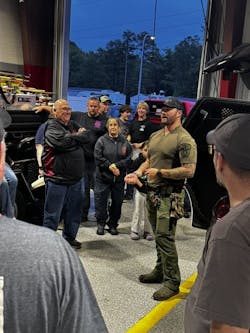Course on Emergency Care for Police K-9s Provides Much-Needed Training
What to know
- Calvert County, Maryland, Sheriff's Deputy Sean Hendrickson has developed a first-of-its-kind K-9 awareness and emergency care course for fire and EMS personnel, drawing on his dual experience as a K-9 handler and volunteer firefighter.
- The course covers critical topics such as K-9 emergency medical care, fire response at handler residences and rescue procedures during patrol vehicle crashes involving K-9s.
- Strong interagency support and collaboration highlights the importance of cross-discipline training to enhance safety and effectiveness in joint public safety operations.
It’s of interest to note that many law enforcement professionals either are or have also been volunteer firefighters, EMTs, paramedics, etc. It’s an observable circumstance that if you put cops and firefighters in the same room, it’s inevitable that they’ll start poking fun at each other and the rivalry between the two major groups of public safety disciplines probably dates back for as long as the two separate uniforms have existed. For all that, when things go sideways in reality, they work side by side with deep respect for each other and a sense of teamwork rarely found anywhere else except the military. That outlook was recently demonstrated in Calvert County, Maryland when one of the local volunteer fire houses asked a K-9 Handler for a course covering police K-9 concerns that the firefighters, EMTs and paramedics might come across.
The K-9 Handler, Deputy Sean Hendrickson, still a volunteer firefighter himself, responded by developing a course curriculum, getting approval from his Sergeant to present it and promptly scheduling the course in coordination with the firehouse. That firehouse, Solomons Volunteer Rescue Squad & Fire Department, invited members of other firehouses to attend as well, with several members of the St. Leonard Volunteer Fire Company attending. When Deputy Hendrickson was interviewed as to the contents of the course, it was quite enlightening. Think about it: how much does a volunteer firefighter (or a paid firefighter for that matter) really need to know about law enforcement K-9s? Quite a bit actually, but it’s not obvious until you start asking questions.
One of the most blatant information needs, and it should be a training point for every firefighter anymore, is, “What do we do if we respond to a residential fire and there is a police K-9 in the kennel?” That was one of the questions answered in the course, and (in case it isn’t clearly understood) the K-9’s life is more important than the structure fire. Get the K-9 to safety first and then deal with the fire. It’s just like rescuing people (although rescuing people before the K-9 is the priority—as much as any K-9 Handler might not like to admit it).
One strength Deputy Hendrickson had in presenting the course is that he had experience as a firefighter. Like many of us, he’d spent years as a volunteer so he had some insight into how fire and emergency medical services worked. Keeping his years of volunteer firefighting/EMS service in mind, he developed the course from the perspective of a certified and experienced K-9 Handler who regularly works with the county’s Special Operations Team. In fact, the SOT Medic helped him to present the course where the EMS for K9s topics were concerned. Further, it helped that his entire chain of command supported the idea from his Sergeant to his Chief Deputy and the Sheriff himself.
The course, which ran about three hours covered topics to include:
- Overview of the CCSO K-9 Unit
- Home Kennel Overview
- Procedures for fire incidents around K-9 handler residences and kennels
- K-9 Emergency Care
- Monitoring working dog temperatures (heat stress/exhaustion)
- Pulse taking procedures
- Respirations
- Signs of trauma via mucous membranes
- K-9 CPR
- Tension pneumothorax and intervention
- Massive hemorrhage control
- Airway and circulatory management
- Gastric Dilation and Volvulus
- Aviation and Transport Procedures
- Handler-involved Motor Vehicle Collision Procedures
- Handling scenarios where the handler is trapped in a vehicle
- K-9 TCCC Equipment Review
- K-9 Vehicle Review
If you take a look at that topic list, it’s easy to understand just how common a need for the knowledge might be. While there may be a greater likelihood of fire and EMS responding to a traffic accident involving a K-9 Patrol vehicle, how to handle the K-9 concerns at a K-9’s residence is necessary information. When it comes to the patrol vehicle accidents, it’s necessary for the responding firefighters and EMTs to understand how a K-9 patrol vehicle differs from a common patrol vehicle, enabling better or more efficient rescue performance if one is involved in an accident. Those follow-on topics of handling the situation if a handler is trapped and/or if the K-9 is injured are key.
Something that startled the interviewer, himself a long time law enforcement veteran, was that this course was - as far as anyone involved knew - was the first of its kind in the country. Even most patrol officers, those likely to be working side-by-side with K-9 teams and/or responding to a traffic accident involving a K-9 patrol vehicle, don’t usually receive this training. It’s the outlook of this author that such should be developed and provided nationwide to support and protect the K-9 teams, both the handler and their four-pawed partners.
In our March/April issue the Calvert County Sheriff’s office was mentioned because one of their deputies, assigned as a school resource officer, played a role in developing a communication tool for law enforcement professionals answering calls that involved people with autism. Now we’re learning about a K9 handler from that agency developing and delivering one-of-a-kind training that we hope to see spread nationwide. We’d like to thank them for sharing the information with us and we look forward to helping them spread this knowledge.
About the Author
Lt. Frank Borelli (ret), Editorial Director
Editorial Director
Lt. Frank Borelli is the Editorial Director for the Officer Media Group. Frank brings 20+ years of writing and editing experience in addition to 40 years of law enforcement operations, administration and training experience to the team.
Frank has had numerous books published which are available on Amazon.com, BarnesAndNoble.com, and other major retail outlets.
If you have any comments or questions, you can contact him via email at [email protected].


